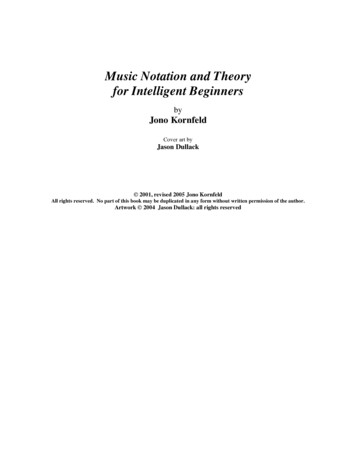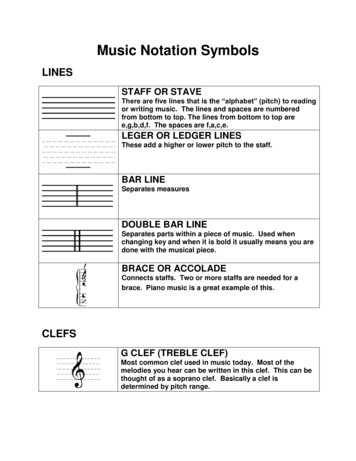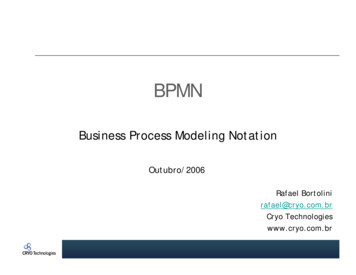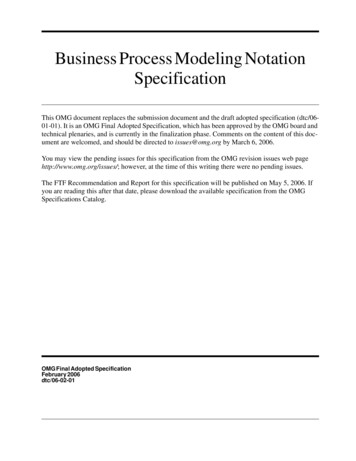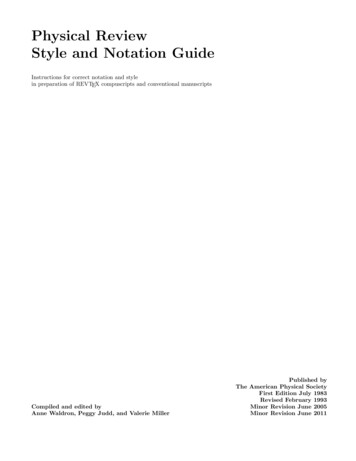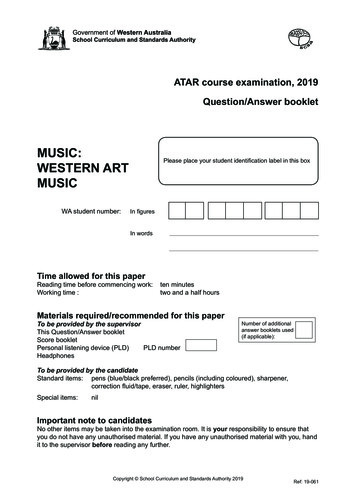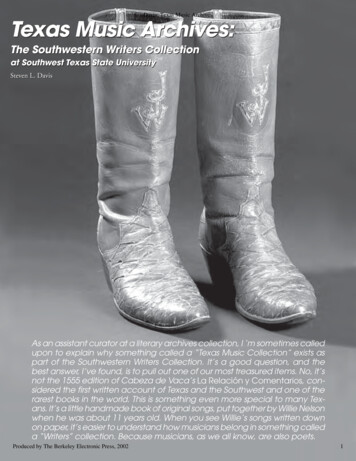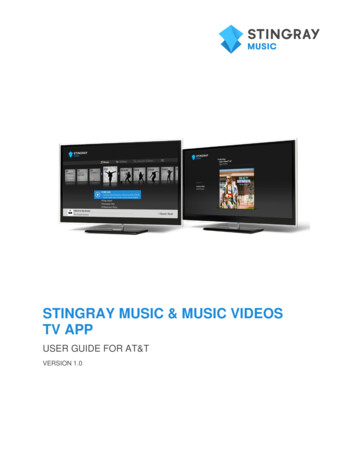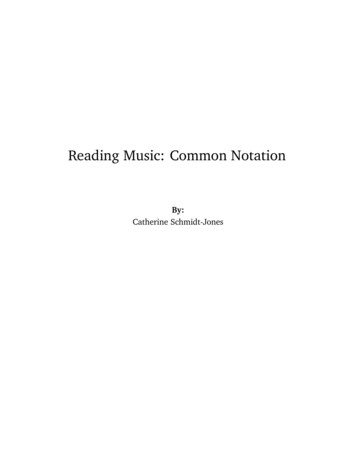
Transcription
Reading Music: Common NotationBy:Catherine Schmidt-Jones
Reading Music: Common NotationBy:Catherine Schmidt-JonesOnline: http://cnx.org/content/col10209/1.9/ CONNEXIONSRice University, Houston, Texas
2008 Catherine Schmidt-JonesThis selection and arrangement of content is licensed under the Creative Commons Attribution License:http://creativecommons.org/licenses/by/1.0
Table of Contents1 Pitch1.11.21.31.41.5The Sta . . . . . . . . . . . . . . . . . . . . . . . . . . . . . . . . . . . . . . . . . . . . . . . . . . . . . . . . . . . . . . . . . . . . . . . . . . . . . . . . . . . . 1Clef . . . . . . . . . . . . . . . . . . . . . . . . . . . . . . . . . . . . . . . . . . . . . . . . . . . . . . . . . . . . . . . . . . . . . . . . . . . . . . . . . . . . . . . . . 4Pitch: Sharp, Flat, and Natural Notes . . . . . . . . . . . . . . . . . . . . . . . . . . . . . . . . . . . . . . . . . . . . . . . . . . . . . . 11Key Signature . . . . . . . . . . . . . . . . . . . . . . . . . . . . . . . . . . . . . . . . . . . . . . . . . . . . . . . . . . . . . . . . . . . . . . . . . . . . . . 14Enharmonic Spelling . . . . . . . . . . . . . . . . . . . . . . . . . . . . . . . . . . . . . . . . . . . . . . . . . . . . . . . . . . . . . . . . . . . . . . . 17Solutions . . . . . . . . . . . . . . . . . . . . . . . . . . . . . . . . . . . . . . . . . . . . . . . . . . . . . . . . . . . . . . . . . . . . . . . . . . . . . . . . . . . . . . . . 242 Time2.12.22.32.42.52.62.7Duration: Note Lengths in Written Music . . . . . . . . . . . . . . . . . . . . . . . . . . . . . . . . . . . . . . . . . . . . . . . . . . 29Duration: Rest Length . . . . . . . . . . . . . . . . . . . . . . . . . . . . . . . . . . . . . . . . . . . . . . . . . . . . . . . . . . . . . . . . . . . . . 34Time Signature . . . . . . . . . . . . . . . . . . . . . . . . . . . . . . . . . . . . . . . . . . . . . . . . . . . . . . . . . . . . . . . . . . . . . . . . . . . . 36Pickup Notes and Measures . . . . . . . . . . . . . . . . . . . . . . . . . . . . . . . . . . . . . . . . . . . . . . . . . . . . . . . . . . . . . . . . 41Dots, Ties, and Borrowed Divisions . . . . . . . . . . . . . . . . . . . . . . . . . . . . . . . . . . . . . . . . . . . . . . . . . . . . . . . . . 43Tempo . . . . . . . . . . . . . . . . . . . . . . . . . . . . . . . . . . . . . . . . . . . . . . . . . . . . . . . . . . . . . . . . . . . . . . . . . . . . . . . . . . . . . 47Repeats and Other Musical Road Map Signs . . . . . . . . . . . . . . . . . . . . . . . . . . . . . . . . . . . . . . . . . . . . . . . 50Solutions . . . . . . . . . . . . . . . . . . . . . . . . . . . . . . . . . . . . . . . . . . . . . . . . . . . . . . . . . . . . . . . . . . . . . . . . . . . . . . . . . . . . . . . . 553 Style3.1 Dynamics and Accents in Music . . . . . . . . . . . . . . . . . . . . . . . . . . . . . . . . . . . . . . . . . . . . . . . . . . . . . . . . . . . . 573.2 Articulation . . . . . . . . . . . . . . . . . . . . . . . . . . . . . . . . . . . . . . . . . . . . . . . . . . . . . . . . . . . . . . . . . . . . . . . . . . . . . . . . 60Solutions . . . . . . . . . . . . . . . . . . . . . . . . . . . . . . . . . . . . . . . . . . . . . . . . . . . . . . . . . . . . . . . . . . . . . . . . . . . . . . . . . . . . . . . . ?Index . . . . . . . . . . . . . . . . . . . . . . . . . . . . . . . . . . . . . . . . . . . . . . . . . . . . . . . . . . . . . . . . . . . . . . . . . . . . . . . . . . . . . . . . . . . . . . . . 65Attributions . . . . . . . . . . . . . . . . . . . . . . . . . . . . . . . . . . . . . . . . . . . . . . . . . . . . . . . . . . . . . . . . . . . . . . . . . . . . . . . . . . . . . . . . . 67
iv
Chapter 1Pitch1.1 The Sta 1People were talking long before they invented writing. People were also making music long before anyonewrote any music down. Some musicians still play "by ear" (without written music), and some music traditionsrely more on improvisation and/or "by ear" learning. But written music is very useful, for many of the samereasons that written words are useful. Music is easier to study and share if it is written down. Westernmusic2 specializes in long, complex pieces for large groups of musicians singing or playing parts exactly asa composer intended. Without written music, this would be too di cult. Many di erent types of musicnotation have been invented, and some, such as tablature3 , are still in use. By far the most widespread wayto write music, however, is on a sta . In fact, this type of written music is so ubiquitous that it is calledcommon notation.1.1.1 The Sta The sta (plural staves) is written as ve horizontal parallel lines. Most of the notes (Section 2.1) of themusic are placed on one of these lines or in a space in between lines. Extra ledger lines may be added toshow a note that is too high or too low to be on the sta . Vertical bar lines divide the sta into shortsections called measures or bars. A double bar line, either heavy or light, is used to mark the ends oflarger sections of music, including the very end of a piece, which is marked by a heavy double bar.1 This content is available online at http://cnx.org/content/m10880/2.9/ .2 "What Kind of Music is That?" http://cnx.org/content/m11421/latest/ 3 "Reading Guitar Tablature" http://cnx.org/content/m11905/latest/ 1
2CHAPTER 1.PITCHThe Sta Figure 1.1: The ve horizontal lines are the lines of the sta . In between the lines are the spaces. If anote is above or below the sta , ledger lines are added to show how far above or below. Shorter verticallines are bar lines. The most important symbols on the sta , the clef symbol, key signature and timesignature, appear at the beginning of the sta .Many di erent kinds of symbols can appear on, above, and below the sta . The notes (Section 2.1)and rests (Section 2.2) are the actual written music. A note stands for a sound; a rest stands for a silence.Other symbols on the sta , like the clef (Section 1.2) symbol, the key signature (Section 1.4), and the timesignature (Section 2.3), tell you important information about the notes and measures. Symbols that appearabove and below the music may tell you how fast it goes (tempo (Section 2.6) markings), how loud it shouldbe (dynamic (Section 3.1) markings), where to go next (repeats (Section 2.7), for example) and even givedirections for how to perform particular notes (accents (p. 59), for example).Other Symbols on the Sta Figure 1.2: The bar lines divide the sta into short sections called bars or measures. The notes (sounds)and rests (silences) are the written music. Many other symbols may appear on, above, or below the sta ,giving directions for how to play the music.1.1.2 Groups of stavesStaves are read from left to right. Beginning at the top of the page, they are read one sta at a time unlessthey are connected. If staves should be played at the same time (by the same person or by di erent people),they will be connected at least by a long vertical line at the left hand side. They may also be connected bytheir bar lines. Staves played by similar instruments or voices, or staves that should be played by the same
3person (for example, the right hand and left hand of a piano part) may be grouped together by braces orbrackets at the beginning of each line.Groups of Staves(a)(b)Figure 1.3: (b) When many staves are to be played at the same time, as in this orchestral score, thelines for similar instruments - all the violins, for example, or all the strings - may be marked with bracesor brackets.
4CHAPTER 1.PITCH1.2 Clef41.2.1 Treble Clef and Bass ClefThe rst symbol that appears at the beginning of every music sta (Section 1.1) is a clef symbol. It is veryimportant because it tells you which note (Section 2.1) (A, B, C, D, E, F, or G) is found on each line orspace. For example, a treble clef symbol tells you that the second line from the bottom (the line that thesymbol curls around) is "G". On any sta , the notes are always arranged so that the next letter is alwayson the next higher line or space. The last note letter, G, is always followed by another A.Treble ClefFigure 1.4A bass clef symbol tells you that the second line from the top (the one bracketed by the symbol's dots)is F. The notes are still arranged in ascending order, but they are all in di erent places than they were intreble clef.Bass ClefFigure 1.54 Thiscontent is available online at http://cnx.org/content/m10941/2.15/ .
51.2.2 Memorizing the Notes in Bass and Treble ClefOne of the rst steps in learning to read music in a particular clef is memorizing where the notes are. Manystudents prefer to memorize the notes and spaces separately. Here are some of the most popular mnemonicsused.(a)(b)Figure 1.6: You can use a word or silly sentence to help you memorize which notes belong on the linesor spaces of a clef. If you don't like these ones, you can make up your own.1.2.3 Moveable ClefsMost music these days is written in either bass clef or treble clef, but some music is written in a C clef. TheC clef is moveable: whatever line it centers on is a middle C5 .5 "Octavesand the Major-Minor Tonal System" http://cnx.org/content/m10862/latest/#p2bb
6CHAPTER 1.PITCHC ClefsFigure 1.7: All of the notes on this sta are middle C.The bass and treble clefs were also once moveable, but it is now very rare to see them anywhere but intheir standard positions. If you do see a treble or bass clef symbol in an unusual place, remember: trebleclef is a G clef ; its spiral curls around a G. Bass clef is an F clef ; its two dots center around an F.Moveable G and F ClefsFigure 1.8: It is rare these days to see the G and F clefs in these nonstandard positions.Much more common is the use of a treble clef that is meant to be read one octave below the writtenpitch. Since many people are uncomfortable reading bass clef, someone writing music that is meant to soundin the region of the bass clef may decide to write it in the treble clef so that it is easy to read. A very small"8" at the bottom of the treble clef symbol means that the notes should sound one octave lower than theyare written.
7Figure 1.9: A small "8" at the bottom of a treble clef means that the notes should sound one octavelower than written.1.2.4 Why use di erent clefs?Music is easier to read and write if most of the notes fall on the sta and few ledger lines (p. 1) have to beused.Figure 1.10: These scores show the same notes written in treble and in bass clef. The sta with fewerledger lines is easier to read and write.The G indicated by the treble clef is the G above middle C6 , while the F indicated by the bass clef is theF below middle C. (C clef indicates middle C.) So treble clef and bass clef together cover many of the notesthat are in the range7 of human voices and of most instruments. Voices and instruments with higher rangesusually learn to read treble clef, while voices and instruments with lower ranges usually learn to read bassclef. Instruments with ranges that do not fall comfortably into either bass or treble clef may use a C clef ormay be transposing instruments8 .6 "Octaves and the Major-Minor Tonal System" http://cnx.org/content/m10862/latest/#p2bb 7 "Range" http://cnx.org/content/m12381/latest/ 8 "Transposing Instruments" http://cnx.org/content/m10672/latest/
8CHAPTER 1.PITCHFigure 1.11: Middle C is above the bass clef and below the treble clef; so together these two clefs covermuch of the range of most voices and instruments.Exercise 1.1Write the name of each note below the note on each sta in Figure 1.12.(Solution on p. 24.)Figure 1.12Exercise 1.2(Solution on p. 24.)Choose a clef in which you need to practice recognizing notes above and below the sta in Figure 1.13. Write the clef sign at the beginning of the sta , and then write the correct note namesbelow each note.
9Figure 1.13Exercise 1.3(Solution on p. 25.)Figure 1.14 gives more exercises to help you memorize whichever clef you are learning. You mayprint these exercises as a PDF worksheet9 if you like.9 .pdf
10CHAPTER 1.Figure 1.14PITCH
111.3 Pitch: Sharp, Flat, and Natural Notes10The pitch of a note is how high or low it sounds. Pitch depends on the frequency11 of the fundamental12sound wave of the note. The higher the frequency of a sound wave, and the shorter its wavelength13 , thehigher its pitch sounds. But musicians usually don't want to talk about wavelengths and frequencies. Instead,they just give the di erent pitches di erent letter names: A, B, C, D, E, F, and G. These seven letters nameall the natural notes (on a keyboard, that's all the white keys) within one octave. (When you get to theeighth natural note, you start the next octave14 on another A.)Figure 1.15: The natural notes name the white keys on a keyboard.But in Western15 music there are twelve notes in each octave that are in common use. How do you namethe other ve notes (on a keyboard, the black keys)?10 This content is available online at http://cnx.org/content/m10943/2.9/ .11 "Acoustics for Music Theory": Section Wavelength, Frequency, and Pitch http://cnx.org/content/m13246/latest/#s2 12 "Harmonic Series" http://cnx.org/content/m11118/latest/#p1c 13 "Acoustics for Music Theory": Section Wavelength, Frequency, and Pitch http://cnx.org/content/m13246/latest/#s2 14 "Octaves and the Major-Minor Tonal System" http://cnx.org/content/m10862/latest/ 15 "What Kind of Music is That?" http://cnx.org/content/m11421/latest/
12CHAPTER 1.PITCHFigure 1.16: Sharp, at, and natural signs can appear either in the key signature (Section 1.4), or rightin front of the note that they change.A sharp sign means "the note that is one half step16 higher than the natural note". A at sign means"the note that is one half step lower than the natural note". Some of the natural notes are only one half stepapart, but most of them are a whole step17 apart. When they are a whole ste
and rests (silences) are the written music. Many other symbols may appear on, above, or below the sta , giving directions for how to play the music. 1.1.2 Groups of staves Staves are read from left to right. Beginning at the top of the page, they are read one sta at a time unless they are connected. If staves should be played at the same time (by the same person or by di erent people),File Size: 2MBPage Count: 75
